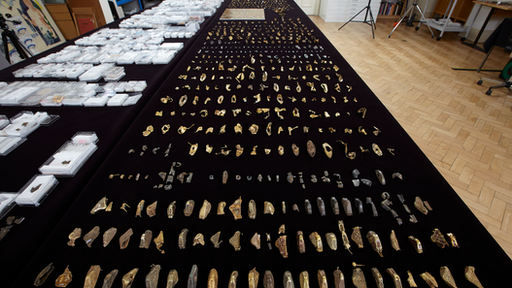Staffordshire Hoard finds together for first time
- Published
The fragments have been cleaned up, catalogued and analysed since 2012
All 4,000 pieces of the UK's largest find of Anglo-Saxon objects have been brought together for the first time since their discovery.
The Staffordshire Hoard, which is valued at £3.2m, attracted worldwide attention when it was found in 2009.
The collection is normally displayed across four sites, at the Potteries Museum, Lichfield Cathedral, Tamworth Castle and Birmingham Museum.
However, it came together for a two-week research project.
Deb Klemperer, principal collections officer at The Potteries Museum, said the pieces were researched in Birmingham.
She said: "You could see how all the pieces fitted together. It was absolutely fantastic.
She said broken fragments were joined to reveal new objects including sword fittings and various types of Saxon and reused Roman glass were identified.

Specialist analysis of the hoard is due to be completed in May
Stoke-on-Trent City councillor Adrian Knapper said: "This breathtaking collection of exquisite gold, silver and garnet craftsmanship continues to dazzle and aid our understanding of such a little known, yet clearly incredibly artistically advanced period in our country's history.
"This is the first time every one of the thousands of detailed artefacts have been laid out in a fully cleaned state and, like the oldest and most expensive jigsaw puzzle, they are revealing a bigger picture that in this instance is helping answer questions that have remained unknown for centuries about our ancient ancestors."
The original hoard was found by Terry Herbert with a metal detector. The artefacts have been dated to the 7th and 8th Centuries.
Specialist analysis of the hoard is due to be completed in May.
- Published1 May 2013
- Published13 March 2013
- Published18 December 2012
- Published3 July 2011